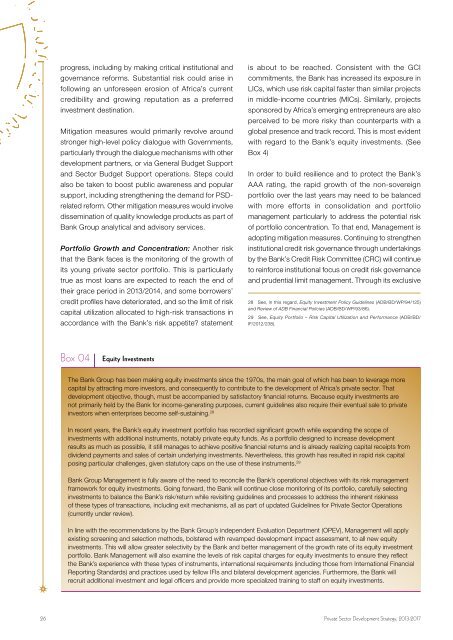2013-2017_-_Private_Sector_Development_Strategy
2013-2017_-_Private_Sector_Development_Strategy
2013-2017_-_Private_Sector_Development_Strategy
You also want an ePaper? Increase the reach of your titles
YUMPU automatically turns print PDFs into web optimized ePapers that Google loves.
progress, including by making critical institutional and<br />
governance reforms. Substantial risk could arise in<br />
following an unforeseen erosion of Africa’s current<br />
credibility and growing reputation as a preferred<br />
investment destination.<br />
Mitigation measures would primarily revolve around<br />
stronger high-level policy dialogue with Governments,<br />
particularly through the dialogue mechanisms with other<br />
development partners, or via General Budget Support<br />
and <strong>Sector</strong> Budget Support operations. Steps could<br />
also be taken to boost public awareness and popular<br />
support, including strengthening the demand for PSDrelated<br />
reform. Other mitigation measures would involve<br />
dissemination of quality knowledge products as part of<br />
Bank Group analytical and advisory services.<br />
Portfolio Growth and Concentration: Another risk<br />
that the Bank faces is the monitoring of the growth of<br />
its young private sector portfolio. This is particularly<br />
true as most loans are expected to reach the end of<br />
their grace period in <strong>2013</strong>/2014, and some borrowers’<br />
credit profiles have deteriorated, and so the limit of risk<br />
capital utilization allocated to high-risk transactions in<br />
accordance with the Bank’s risk appetite statement<br />
is about to be reached. Consistent with the GCI<br />
commitments, the Bank has increased its exposure in<br />
LICs, which use risk capital faster than similar projects<br />
in middle-income countries (MICs). Similarly, projects<br />
sponsored by Africa’s emerging entrepreneurs are also<br />
perceived to be more risky than counterparts with a<br />
global presence and track record. This is most evident<br />
with regard to the Bank’s equity investments. (See<br />
Box 4)<br />
In order to build resilience and to protect the Bank’s<br />
AAA rating, the rapid growth of the non-sovereign<br />
portfolio over the last years may need to be balanced<br />
with more efforts in consolidation and portfolio<br />
management particularly to address the potential risk<br />
of portfolio concentration. To that end, Management is<br />
adopting mitigation measures. Continuing to strengthen<br />
institutional credit risk governance through undertakings<br />
by the Bank’s Credit Risk Committee (CRC) will continue<br />
to reinforce institutional focus on credit risk governance<br />
and prudential limit management. Through its exclusive<br />
28 See, in this regard, Equity Investment Policy Guidelines (ADB/BD/WP/94/125)<br />
and Review of ADB Financial Policies (ADB/BD/WP/93/86).<br />
29 See, Equity Portfolio – Risk Capital Utilization and Performance (ADB/BD/<br />
IF/2012/238).<br />
Box 04<br />
Equity Investments<br />
The Bank Group has been making equity investments since the 1970s, the main goal of which has been to leverage more<br />
capital by attracting more investors, and consequently to contribute to the development of Africa’s private sector. That<br />
development objective, though, must be accompanied by satisfactory financial returns. Because equity investments are<br />
not primarily held by the Bank for income-generating purposes, current guidelines also require their eventual sale to private<br />
investors when enterprises become self-sustaining. 28<br />
In recent years, the Bank’s equity investment portfolio has recorded significant growth while expanding the scope of<br />
investments with additional instruments, notably private equity funds. As a portfolio designed to increase development<br />
results as much as possible, it still manages to achieve positive financial returns and is already realizing capital receipts from<br />
dividend payments and sales of certain underlying investments. Nevertheless, this growth has resulted in rapid risk capital<br />
posing particular challenges, given statutory caps on the use of these instruments. 29<br />
Bank Group Management is fully aware of the need to reconcile the Bank’s operational objectives with its risk management<br />
framework for equity investments. Going forward, the Bank will continue close monitoring of its portfolio, carefully selecting<br />
investments to balance the Bank’s risk/return while revisiting guidelines and processes to address the inherent riskiness<br />
of these types of transactions, including exit mechanisms, all as part of updated Guidelines for <strong>Private</strong> <strong>Sector</strong> Operations<br />
(currently under review).<br />
In line with the recommendations by the Bank Group’s independent Evaluation Department (OPEV), Management will apply<br />
existing screening and selection methods, bolstered with revamped development impact assessment, to all new equity<br />
investments. This will allow greater selectivity by the Bank and better management of the growth rate of its equity investment<br />
portfolio. Bank Management will also examine the levels of risk capital charges for equity investments to ensure they reflect<br />
the Bank’s experience with these types of instruments, international requirements (including those from International Financial<br />
Reporting Standards) and practices used by fellow IFIs and bilateral development agencies. Furthermore, the Bank will<br />
recruit additional investment and legal officers and provide more specialized training to staff on equity investments.<br />
26 <strong>Private</strong> <strong>Sector</strong> <strong>Development</strong> <strong>Strategy</strong>, <strong>2013</strong>-<strong>2017</strong>


